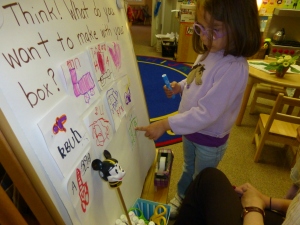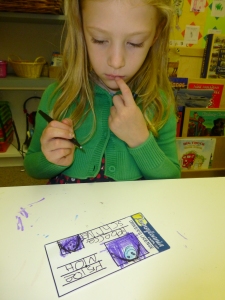The boxes had been chosen, paint had been slathered on, it was time to start adding the finishing touches to our vehicles. Most students added details such as cardboard wheels, steering and otherwise, while other students added items that would be specific to their vehicle. The fire truck friends attached a ladder, hatchet, and hose to fully equip their truck. Wings and feathers were added to the airplane so that “it could fly faster through the air”.
The students tried many different techniques in order to attach these details. Many of the students felt that glue would be the best medium to use. However, when the glue did not stick after a few seconds of pressing, the students seemed confused. Perhaps glue would not work as well as they had once thought.
On to idea number two, tape. But which kind would work best? The students could choose from scotch tape, masking tape, or duct tape. Some students started with the scotch or masking tape first and while this worked for small items, it was not quite sticky enough. One student had the idea to put glue on the sticky side of the tape in the hopes that it would create the stickiest tape that ever existed. Despite the wonderful ingenuity, the tape just flopped off the box and lay lifeless at the bottom of the vehicle.
Option number three? Duct tape. What a wonderful invention! It seems to have just the right amount of stickiness and flexibility that children start asking for strip after strip. The duct tape was used to hang up signs, feathers, seat belts, and airplane wings. It seemed to work better than any other material available. However, when a child began to add paper rolls to their vehicle, a problem arose. The duct tape appeared to be sticking to the tube, but not the box. Hmmm, now what? By chance, a piece of duct tape was sticking off the paper tube and happened to stick to the box as well and it clicked! The child then knew that she had to attach the tape to both the tube and the box in order for it to stay put.
It was obvious that on more than one occasion the students were feeling frustrated with the challenge, but they did not give up! When one strategy fell flat, they reevaluated the situation and materials and started again. Isn’t determination and persistence amazing?!
[slideshow]



